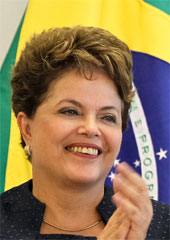Rousseff’s Global Challenge: Do Better Than India
With Modi, India got a new life politically. What about Brazil?
October 28, 2014

Brazilians are both quite enamored with China as a mighty trading partner and very nervous about it at other times. But now that Dilma Rousseff has won reelection, however tightly, the true challenge for Brazil’s near-term political future comes from India.
It was in India where a left-of-center government – under then-Prime Minister Manmohan Singh – also won reelection in 2009, but ended up overstaying its welcome. As it became ever more obvious that his Congress party was losing political steam, it desperately tried to hold onto power by enlarging its governing coalition, the UPA, with ever more political parties.
In the end, the whole Congress edifice became dysfunctional. Mr. Singh, who as finance minister from 1991 to 1996 had been the important architect of India’s economic opening, became a mere shadow of himself.
Time wasted in India
At best, the venerable Mr. Singh was a caretaker prime minister, but definitely not a leader who could get anything meaningful done. In hindsight, it is painfully clear that the two-term prime minister (2004-2014) stayed in office at least for one term longer than was either good for him or the country.
India, as a result, fell way short of the economic progress it must make, not least to absorb the vast numbers of labor market entrants each year that need work – the flip side of its “demographic dividend.”
For all of the Congress party establishment’s best efforts, the mystique of the Gandhi family name, which had long enchanted voters, has finally run its course. In the 2014 election, Indian voters turned to the opposition candidate, the BJP’s Narendra Modi, in impressive numbers.
Equipped with an absolute majority in parliament, he is the first prime minister in India in 30 years able to govern without a coalition partner. That should help him make up for lost time with regard to a dynamic management of the economy.
Brazil: Another detour?
Brazil can only hope to escape India’s fate. Under the Congress party’s Brazilian equivalent, the Workers’ Party (PT), the country has had an impressive run economically, boosted by a commodity boom.
After the transformative Lula da Silva, the country’s president from 2002 to 2010, his handpicked successor, Dilma Rousseff, had another four-year run and has now gained reelection for a second term that will have her in power through 2019.
To be sure, the PT has achieved some very important transformations, mainly in the social sector by reducing poverty via such programs as the Bolsa Familia.
But there is also no denying that the PT has run out of steam. Rousseff’s real failure – in addition to failing to rein in the corruption monster, which may yet fell her (even though she is now reelected) – was on the reform side.
Specifically, Rousseff failed to make good use of the good economic times – by implementing overdue labor market reform and political reform, as well as to provide for a more business friendly environment in general.
In addition, Mrs. Rousseff has had a hard time even with core voter groups, especially among the young. And she overplayed the card of boosting growth by relying on state enterprises such as Petrobras.
Brazil’s Singh
To put it charitably, Mrs. Rousseff, much like Mr. Singh in India, has not had much luck during her first term in office. Reforms stagnated and household indebtedness rose, which undermines the gains in expanding the middle class. The competitive stance of Brazil’s industry leaves much to be desired – and corruption remains rampant.
To buttress their waning political fortunes, she and her party have been compelled to make the same move as Congress in India – widening what is already a hard-to-handle coalition of some 30 (sub-)parties even more. Even with the best of intentions, it is a real question under those circumstances whether Rousseff´s PT is able to get the necessary reforms done – even if she personally were perfectly willing to do so.
Brazilian voters did have a real option to exist from the stagnation that the PT has brought with it (and, compared to the Lula times, over itself as well). Aecio Neves, a former governor and the opposition party’s candidate, came tantalizingly close to winning Mrs. Rousseff.
His party, the Social Democratic Party or PSDB – does not consist of political morons. Fernando Henrique Cardoso, Lula’s predecessor as President from 1995 to 2002, laid much of the groundwork for the economic reforms that came to fruition thereafter.
The danger for Brazil is as clear as it is present. The glitz and the hope are already gone. Rousseff managed to eke out another term in office – but that’s hardly mission accomplished. More appropriately, it’s a second chance.
As on the field, so in government?
Considering how soccer-crazy the Brazilians are, it is unfortunate to see that the sport does not provide a helpful metaphor that would give hope for Dilma turning things around. It is rather the opposite. To see why, consider the performance of Brazil’s football team in the 2014 World Cup.
Ten years earlier, in the 1994 tournament held in the Untied States, Brazil´s team was more or less a shadow of a more glorious footballing past. And yet, the squad managed to squeak by and won the World Cup one more time. But instead of reading the writing on the wall, and implement urgent reforms, things were left to fester.
Instead of doing the only sensible thing, reinventing itself in time – say, in time for the 2014 Cup at home – the country clung to the old formula. And so it was that, playing before a shattered home crowd, Brazil got a true whipping by the German team, in a manner that Brazilians will long remember with great embarrassment.
The football pitch can offer nations valuable lessons, especially Brazil. Rousseff and the PT are in power at least for one more round, which puts them into the position to celebrate the glory of the 2016 Olympic Games to be held in Rio de Janeiro. But it is very uncertain, looking at the political and economic spheres, whether Brazil can spare itself another sub-par performance over the next four years.
The challenge for Rousseff then is to outperform India. That may come as a shock to Brazilians, but the challenge – albeit at a different level of economic development – is very real. India and Brazil are indeed quite similar institutionally in pivotal ways: Both countries have powerful states. Both have constitutions that prevent reform – and both have a very fragmented political system.
Takeaways
Does Brazil need to shake up its governing formula? If not, the governing Workers’ Party could fall apart.
Brazil’s Workers’ Party may look invincible, but so did India’s Gandhi family. Brazil may want to shake things up.
What can Brazil learn from India? When a good governing coalition has run its course.
Read previous

Global Women
Dilma Redux?
October 28, 2014
